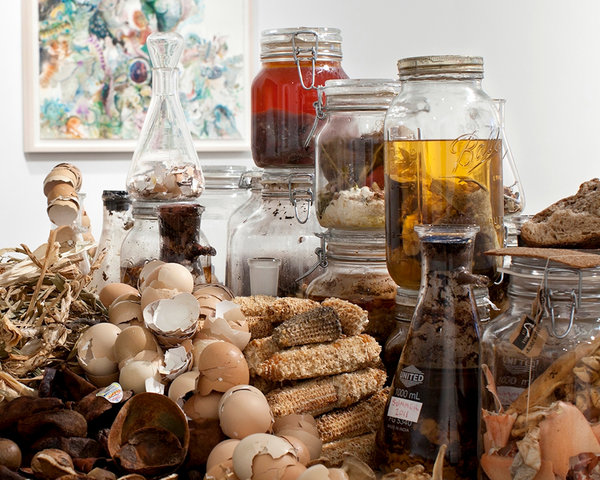Art Today
May 13, 2015

SEVEN cultural institutions in New York and Connecticut are preparing to host coordinated art exhibits on the “Seven Deadly Sins.” The Katonah Museum will focus on gluttony, reports The New York Times, “with ‘Emilie Clark: The Delicacy of Decomposition,’ an installation that comments on consumption and decay. It will contain an arrangement of Ms. Clark‘s family’s preserved food waste, delicate watercolors that echo the moldering fare and an interactive ‘Research Station’ equipped with a microscope, drawing pad, and jarred and stuffed specimens.”
The Times reports:
Does this predominance of sin mirror greater immorality in society today? Bartholomew Bland, deputy director of the Hudson River Museum, doesn’t think so. Mr. Bland’s longstanding fascination with the idea of sin was the seed for the collaboration. “Sin isn’t more prevalent,” he said. “We’re just more accepting of it. It’s more explicit, more visible, more in your face.”
— Comments —
Mary writes:
The utter lameness of the art world today is on display here: the naval-gazing and self-focus; the ubiquitous titillating element; the attempt to make meaningful statements about a debased, Godless culture using debased, Godless ideas; the decline of social order, which can be blamed at least in part on the patrons of “works” such as these (art reflects but also forms culture). That a director of an art museum would confess to a “longstanding fascination” with sin is in itself fascinating, first of all because of the ignorance of the statement – one is not usually “fascinated”, which implies a certain detachment, by something they know to be gravely dangerous to themselves; but more importantly because this remark reveals an acknowledgement of sin as a reality, even as the sayer remains apart from it. He looks at sin as a child would inspect an ant hill with a magnifying glass.
Would anyone come to see this show if it weren’t given a titillating name, with sin as the plaything of the artist? If parts of it didn’t promise to push the envelope a bit with it’s no one-under-18 designation? If it weren’t given legitimacy through its venue of attractive and chic galleries and museums? If the educated in this country, those likely to take in such a display, weren’t positively starved for meaningful art and satisfaction through cultural experience, and therefore will accept whatever is presented on a nice Sunday afternoon without objection?
While the elite join hands and lament the Duck Dynasty culture of the common man, they – and I say “they” as “they” comprise the private collectors/providers of endowments that power the art world – feed us the worst kind of nonsense parading as art: Rotting food waste on a table as commentary on gluttony; a devilish-looking naked man visibly aroused as an entry for lust; reclining chairs lined up with video screens (showing the installments for the other sins) as a view on sloth; etc. etc. The recliner one is described as “cheeky”; but cheekiness does not sustain, nor does pornography, nor do silly “installations.”
In large part the blame for this state of affairs is on the shoulders of the educated wealthy and the abandonment of noblesse oblige. For several centuries they have rested on their laurels, gliding along on the coattails of Christianity and classical education. Indeed, it’s a testimony to just how essential the roots of the West are that it has taken this long just to weaken it. But weaken it they (we) have. Our culture held together while they (we) indulged in, let’s see….oh, yes: sloth, gluttony, lust, avarice, wrath, pride and envy. This display is meant to be thought-provoking and amusing, a commentary on the emptiness and superficiality of modern living. But scratch the surface and it ironically reveals much more: how profoundly superficial and empty the arts themselves are today – which don’t simply mirror but also drive culture – because of the abandonment of real culture; in a nutshell, through the seven deadly sins. Unless of course that was the intention of this show all along. Somehow I doubt it.
Laura writes:
Right, it inadvertently says it all.
We can only reel in disgust at what goes for high culture today.
Paul C. writes:
I can top that with structures erected on “Veterans” Boulevard (formerly Veterans Highway before urban sprawl) in my section of Metairie, Louisiana. The moronic politicians can’t even keep the grass cut on the neutral grounds (medians) regularly. Yet they spend enormous sums on nonsense.
We had a beautiful, closely-cut St. Augustine-grass neutral ground on Loyola Avenue in New Orleans while I grew up. There was even a grass mound that had an intriguing clock sticking out of the mound. It was not a self-contained clock placed on the mound. It somehow had its central fulcrum embedded in the grass mound and the big arms would rotate past Roman numerals planted on the grass mound. A real treat. Gone. Instead, I watched from my office window, which overlooked Loyola until Katrina, over the years as the City destroyed it. At first, they started planting labor-intensive greenery and flowers that were tended by ex-Vietnamese, who dressed as they did in Vietnam. Large amounts of the City needed and need the grass cut regularly. But no. The high-society twits insist on extravagance in a poor city while they live in mansions on massively potholed streets. (At least my adjacent parish takes care of its street surfaces.)
The tending continued but was followed by construction of a supposedly cancer-themed small park, the purpose of which is impenetrable unless one goes up and reads the purpose. Even then, it is actually a celebration of multiculturalism. Exactly what do these structures have to do with cancer survivors? It was a beautiful, wide green lawn. Can you imagine the cost of maintaining this stuff?

